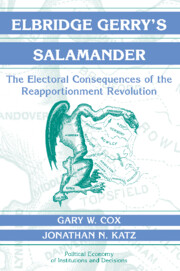Book contents
- Frontmatter
- Contents
- List of Tables and Figures
- Preface
- Part I Introduction
- Part II Democrats and Republicans
- Part III Incumbents and Challengers
- 8 The Growth of the Incumbency Advantage
- 9 Candidate Entry Decisions and the Incumbency Advantage
- 10 Redistricting and Electoral Coordination
- 11 Redistricting, the Probability of Securing a Majority, and Entry
- 12 Reassessing the Incumbency Advantage
- Part IV Conclusion
- References
- Author Index
- Subject Index
- Titles in the series
12 - Reassessing the Incumbency Advantage
Published online by Cambridge University Press: 10 November 2009
- Frontmatter
- Contents
- List of Tables and Figures
- Preface
- Part I Introduction
- Part II Democrats and Republicans
- Part III Incumbents and Challengers
- 8 The Growth of the Incumbency Advantage
- 9 Candidate Entry Decisions and the Incumbency Advantage
- 10 Redistricting and Electoral Coordination
- 11 Redistricting, the Probability of Securing a Majority, and Entry
- 12 Reassessing the Incumbency Advantage
- Part IV Conclusion
- References
- Author Index
- Subject Index
- Titles in the series
Summary
In this chapter, we review the line of argument we have pursued in this part of the book. First, we contrast our view of the increasing incumbency advantage and the vanishing marginals with previously dominant notions. Second, we argue that the question to ask is at least as much about improved electoral coordination as it is about any increase in the “real” incumbency advantage. Third, we review our explanation of why electoral coordination improved and briefly consider some possible alternatives. Fourth, we review our explanation of why the two parties' patterns of vote loss in open seats were so different, both across time and cross-sectionally. Fifth, we reconsider the normative stakes involved in the increasing incumbency advantage.
the incumbency advantage, the vanishing marginals, and democratic dominance of the house
The 1960s brought a remarkable complex of changes to House elections: a sudden increase in the incumbency advantage, a sudden decrease in the number of marginal districts, and a sudden eradication of pro-Republican bias outside the South. The dominant way of viewing these changes is still probably that suggested in the work of Erikson (1972) and Mayhew (1974). In (one reconstruction of) their view, the causal sequence was as follows. (1) The incumbency advantage in House elections – a vote premium that accrued to incumbents per se – increased.
- Type
- Chapter
- Information
- Elbridge Gerry's SalamanderThe Electoral Consequences of the Reapportionment Revolution, pp. 194 - 206Publisher: Cambridge University PressPrint publication year: 2002



